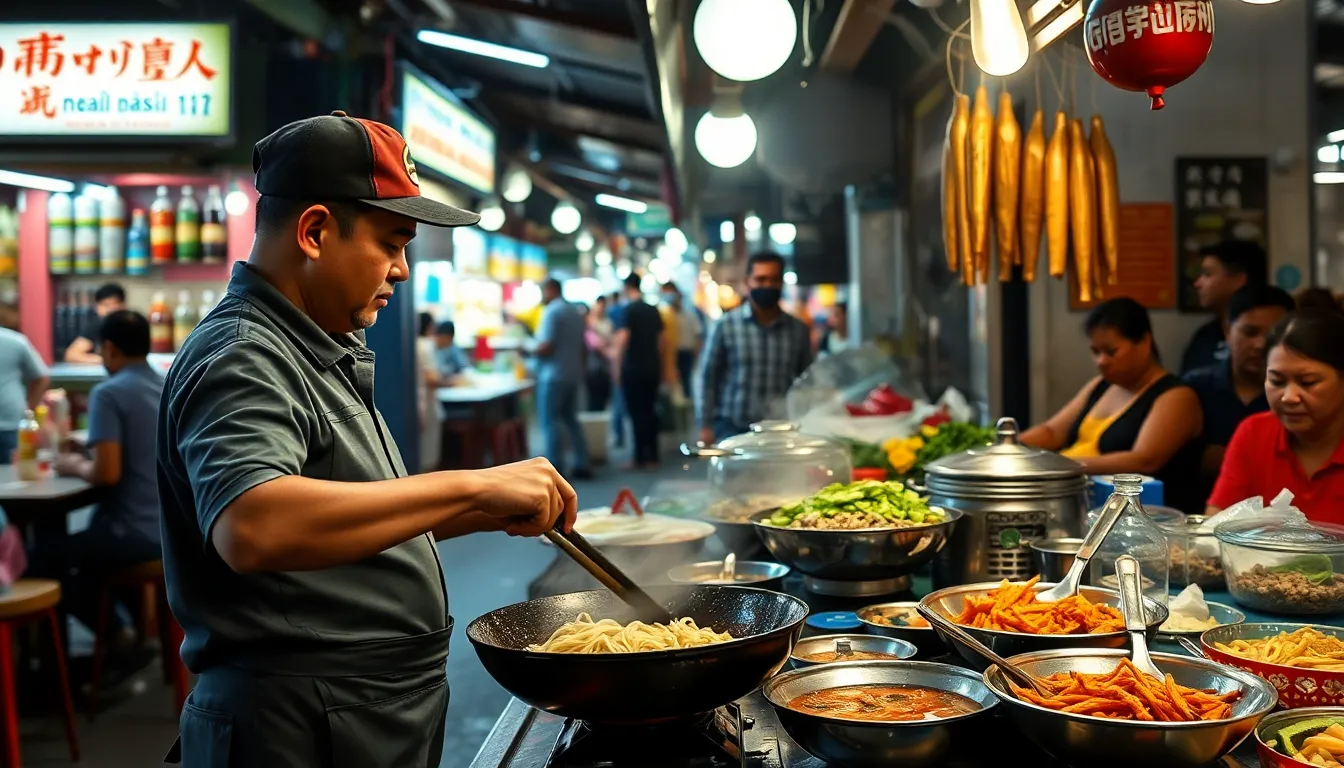Imagine a world where every meal is an adventure and every bite tells a story. Gastronomic travel destinations offer just that—a delicious passport to cultures rich in flavor and tradition. From the bustling street markets of Bangkok to the quaint bistros of Paris, these culinary hotspots transform ordinary trips into mouthwatering experiences that linger long after the last course.
Table of Contents
ToggleTop Gastronomic Travel Destinations
Bangkok shines as a vibrant culinary hub, attracting food lovers with its bustling street markets. This city boasts an array of dishes, from savory Pad Thai to aromatic Tom Yum soup.
Tokyo stands out with its diverse dining options, including sushi bars and ramen shops. Visitors can experience the meticulous craftsmanship that defines Japanese cuisine.
Florence offers more than stunning art; it’s a paradise for food enthusiasts craving authentic Italian flavors. Trattorias serve classic dishes like ribollita and ossobuco, capturing Tuscany’s essence in each bite.
Barcelona’s tapas culture invites travelers to savor small plates bursting with flavor. From patatas bravas to fresh seafood, each dish tells a story of the region’s culinary heritage.
Lima has gained recognition for its innovative gastronomy, combining traditional Peruvian ingredients with modern techniques. Restaurants like Central and Maido highlight the country’s rich biodiversity through unique tasting menus.
Mexico City combines street food with fine dining, showcasing vibrant flavors. Chiles en nogada and tacos al pastor reflect the country’s culinary history and regional diversity.
Istanbul presents a feast for the senses, with its aromatic spices and diverse dishes. Mezes complement main courses like kebabs, creating a unique blend of cultural influences.
Marrakech captivates with its bustling souks and spice markets, offering a look into Moroccan culinary traditions. Dishes like tagine and couscous highlight the importance of spices and fresh ingredients in the region.
Each destination provides unforgettable experiences for those eager to explore global flavors and food traditions.
Unique Culinary Experiences

Culinary experiences shape journeys into unforgettable adventures. They offer a glimpse into local culture through the lens of food.
Street Food Adventures
Street food adventures deliver authentic tastes straight from bustling markets. In Bangkok, vendors serve Pad Thai right from sizzling woks, inviting onlookers to savor each bite. Tokyo boasts yakitori stalls, skewering marinated chicken over open flames, enhancing the city’s vibrant culinary scene. Mexico City’s street vendors dish out tacos al pastor featuring marinated pork, showcasing rich flavors that have become iconic. Barcelona’s tapas bars invite travelers to sample a variety of small plates, like patatas bravas and jamón ibérico, creating an interactive dining experience. Each location provides an opportunity for travelers to taste handcrafted delights that tell a story.
Fine Dining Highlights
Fine dining highlights elevate the culinary experience to new heights. In Florence, Michelin-starred restaurants present dishes featuring truffles and fresh pasta that embody Tuscan tradition. Lima, recognized for its inventive gastronomy, showcases fusion cuisine blending Peruvian ingredients with contemporary techniques. Tokyo’s fine dining scene reflects artistry in sushi, with chefs meticulously preparing each piece from seasonal fish. Paris offers exquisite dining experiences with French classics, such as coq au vin or foie gras, crafted with precision and passion. Each establishment prioritizes quality, allowing guests to indulge in a memorable culinary journey.
Local Ingredients and Flavors
Culinary destinations thrive on local ingredients and flavors. The essence of a region often emerges through its unique produce and traditional cooking methods.
Farm-to-Table Movements
Farm-to-table movements prioritize fresh, locally sourced ingredients. Many restaurants emphasize seasonal produce, creating menus that change with the harvest. In cities like Barcelona, chefs collaborate with local farmers to ensure quality. Tokyo boasts multiple establishments offering vegetables and seafood that arrive from nearby markets, retaining their full flavor. This movement generates not only a more sustainable food system but also deeper connections between diners and their meals.
Traditional Dishes to Try
Traditional dishes reflect the cultural heritage of a destination. In Bangkok, travelers can’t miss enjoying Pad Thai, a staple intertwined with Thai tradition. Mexican cuisine shines with street tacos, showcasing regional variations like al pastor. Florence invites visitors to savor Ribollita, a hearty Tuscan soup rich in local vegetables. Istanbul’s kebabs provide a taste of its rich tapestry of spices and grilling techniques. Each dish tells a story, inviting exploration through authentic flavors.
Cultural Influence on Cuisine
Cultural elements shape cuisine significantly across various regions. Culinary traditions often emerge from historical events, migrations, and exchanges between people. The flavors found in dishes reflect centuries of influence and adaptation, creating unique gastronomic identities.
Historical Significance
Historical events directly impact the evolution of local cuisines. The introduction of spices through trade routes transformed how people cooked and seasoned their food. For instance, the Spanish conquest introduced ingredients like tomatoes and chocolate to European cuisine. In Mexico, indigenous ingredients fused with European techniques, leading to a distinctive culinary culture. This blend of traditions enriches dishes like mole, showcasing both history and technique in its complex flavors. Knowledge of historical significance enhances appreciation for local foods, allowing travelers to connect their meals with the stories they tell.
Fusion Foods
Fusion cuisine illustrates the blending of diverse culinary traditions. This practice combines techniques and ingredients from different cultures to create innovative dishes. In cities like Los Angeles, chefs merge Latin American flavors with Asian techniques, resulting in unique creations such as Korean tacos. In Lima, Peruvian cuisine incorporates influences from Japanese cooking, leading to dishes like nikkei sushi, which highlights distinct flavor profiles. The unexpected combinations challenge traditional notions of cuisine, inviting diners to experience flavors in new ways. This exploration of fusion foods offers a fresh perspective on culinary experiences, reflecting the ongoing evolution of gastronomy worldwide.
Sustainable Gastronomy
Sustainable gastronomy focuses on practices that protect ecosystems while promoting local food cultures. It enhances culinary experiences by creating bonds between food, community, and environment.
Eco-Friendly Practices
Eco-friendly practices in gastronomy reduce the carbon footprint of food production and consumption. Restaurants increasingly adopt sourcing from local farmers, minimizing transport emissions. Organic farming techniques support biodiversity and improve soil health. Some establishments prioritize seasonal ingredients, ensuring freshness and lowering environmental impact. In many cities, zero-waste initiatives aim to repurpose scraps into new dishes. Commitment to sustainable seafood protects aquatic ecosystems, while plant-based menus reduce reliance on meat production. Implementing these eco-friendly practices leads to delicious meals that also respect the planet.
Responsible Travel Tips
Responsible travel tips enhance the gastronomic experience while supporting local communities. Choosing to dine at locally-owned establishments fosters economic growth. Travelers should research culinary traditions and regional ingredients beforehand, leading to richer encounters. Participating in food tours promotes cultural exchange with local chefs and artisans. Opting for meals prepared with sustainable practices contributes to environmental conservation. Engaging in community-supported agriculture allows diners to connect directly with local food sources. Exploring farmers’ markets enables travelers to discover fresh produce and unique flavors. These responsible choices create a more meaningful and impactful culinary journey.
Gastronomic travel opens up a world of flavors and experiences that enrich every journey. By exploring local cuisines travelers not only savor unique dishes but also connect with the culture and history of each destination. From the bustling markets of Bangkok to the charming streets of Florence each meal tells a story that enhances the travel experience.
Embracing sustainable practices and supporting local communities further deepens this connection. Every culinary adventure offers a chance to appreciate the artistry behind each dish and the traditions that shape them. Travelers are encouraged to indulge in these vibrant food cultures and create lasting memories through their gastronomic explorations.


